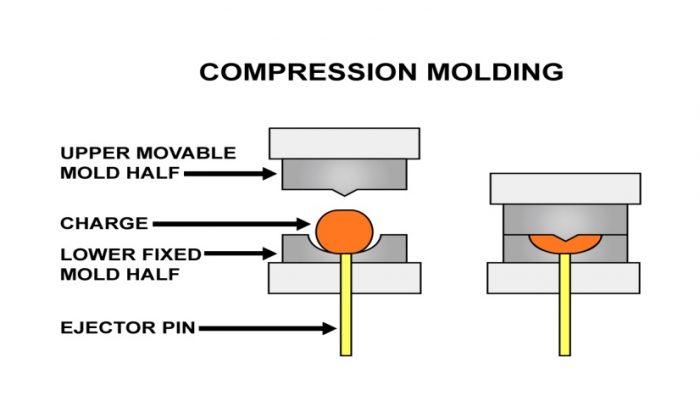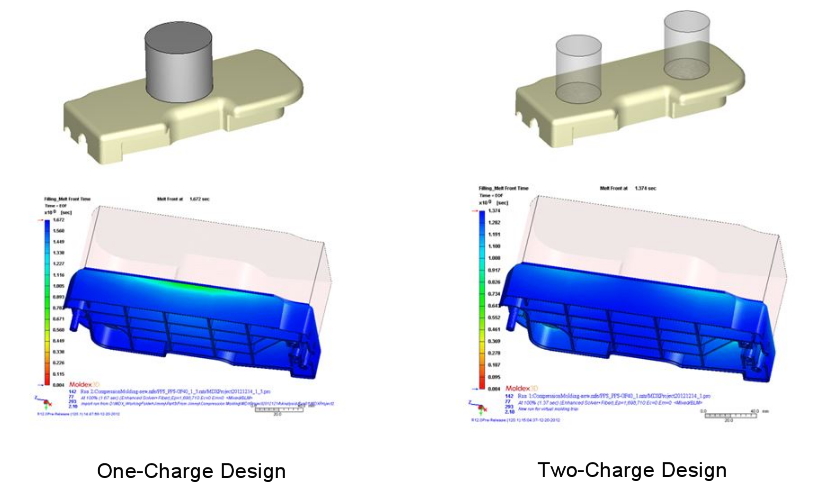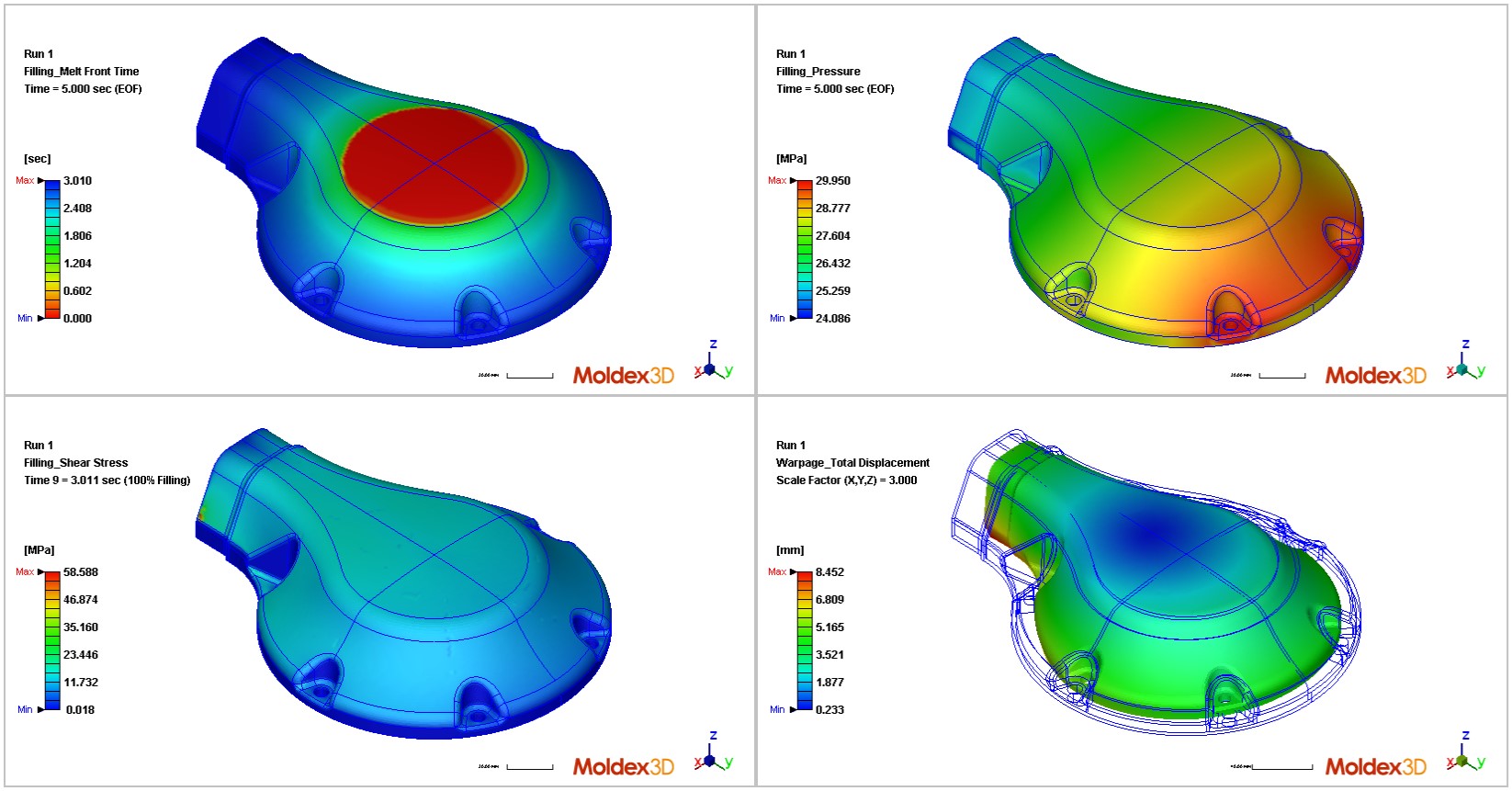1. What is compression molding? How does it work?
Compression Molding is a commonly used manufacturing process in which a molding polymer, called charge or polymer compound, is placed into an open mold cavity. Then the mold is closed to heat and pressurize the compound until it cures into the desired shape. The process is a high-volume-production and low-cost molding method, suitable for making parts with complex appearance, high strength, and temperature resistance. Products made by compression molding also range in sizes, including big parts like aerospace, automotive units to small consumer products.

2. What is the difference between Injection molding and compression molding?
The major difference between compression molding and injection molding is how the plastic enters a mold. In compression molding, a raw plastic material is placed in the preheated mold cavity, then the mold is closed to heat and pressurized the material, while in injection molding, the plastic is first melted then injected into a closed mold.
Compared to compression molding, injection molding could have a shorter cycle time, which is ideal for mass production and more cost-effective. Compression molding is mostly used to produce parts with relatively simple designs. But the compression molding is the oldest mass manufacturing process for thermosetting materials or rubber parts. it is suitable for molding high-strength fiber-reinforced thermoplastics. Also, it reduced injection pressure which enables easier cavity filling and reduced mold in stress, resulting in superior part quality.
3. What are the advantages / disadvantages of compression molding?
Compression molding is an easy-to-operate manufacturing process compared to other molding methods. It doesn’t need special or expensive equipment like injection molding does, so it helps to keep the overall manufacturing cost and tooling cost low, which compensates for its long production time.
Overall, compression molding is a great option for producing bulky and thicker parts (also for composite units), because raw materials can be placed directly into the mold cavity without weight limitation. Also, products made with compression molding are structurally stronger, given that they are manufactured under lower pressure. When the parts are ejected out of the cavity, they will only experience little warping over time, hence ensuring a consistent product quality.
Despite all the benefits mentioned above, compression molding has its disadvantages, including the tendency to flash, slower processing times, longer labor hours and not suitable for making parts with complicated designs.
4. What products are made from compression molding?
- Automotive parts: large parts and panels for cars, engine components, tires, hoods, bumpers, fenders
- Electronics components / Computer and gaming devices: electrical sockets, switches, faceplates, and metering devices, video game controllers
- Dental and medical: caps, plugs, respirator masks, gaskets, syringe stoppers, flow control valves, blood separation machines, ultrasound equipment
- Consumer products: keypads, shower heads, buttons, handles, household products
- Food and beverage / Kitchenware: bowls, cups, plates, seals, O-rings, spatulas, cookware, bottle dispensers and nozzles
5. 6 common compression molding challenges and how Moldex3D can help
When you decide to implement compression molding for manufacturing products, here are 6 common compression molding problems you should be aware of:
- Decide on the proper amount of material to avoid flashing
- Predict how much clamping force is needed for the shot to form the right shape
- Find the best compression parameters to ensure product quality
- Find the right mold design for heating or cooling after the material has been compressed into the mold
- Detect potential flash issue
- Achieve product consistency control
This is where Moldex3D molding simulation jumps in. Moldex3D can help you:
- Visualize pressure distribution, volume shrinkage, residual stress, fiber orientation distribution, etc.
- Predict potential molding defects, such as bleeding or flashing
- Optimize process conditions, such as compression speed, force, or mold temperature
- Support fiber orientation analyses
- Support parallel processing to speed up the simulation
- Support the molding simulation of single or multiple charge design

*Check out our customer success story and see how we provide customized solution for challenging compression molding process – Novel Two-step CAE Method for Sheet Materials in Compression Molding

We offer a comprehensive solution in compression molding simulation, from pre-processing to post-processing. A good deal of the software’s add-ons supports the Moldex3D Compression Molding module and simulate thermoset, thermoplastic, and fiber-reinforced polymer. It also provides detailed analysis for optics and residual stress analysis with viscoelasticity, reducing expensive and time-consuming trial-and error procedures.
Find out what features are included in the compression molding solution add-on!
For more molding tips and tricks, feel free to sign up at our Live Webinar Series or subscribe to Molding Innovation Newsletter to receive monthly molding updates.